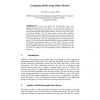Free Online Productivity Tools
i2Speak
i2Symbol
i2OCR
iTex2Img
iWeb2Print
iWeb2Shot
i2Type
iPdf2Split
iPdf2Merge
i2Bopomofo
i2Arabic
i2Style
i2Image
i2PDF
iLatex2Rtf
Sci2ools
ESANN
2000
2000
Evaluating SOMs using order metrics
It has been shown that self-organized maps, when adequately trained with the set of integers 1 to 32, lay out real numbers in a 2D map in an ordering that is superior to any of the known 2D orderings, such as the Cantor-diagonal, Morton, Peano-Hilbert, raster-scan, row-prime, spiral, and random orderings. Two 2D order metrics (Average Direct Neighbor Distance and Average Unit Disorder) have been used to assess the quality of a map's 2D ordering. It is shown here that these same order metrics are useful in assessing the quality of the self-organization process itself. Based on these metrics, it can be determined whether the SOM has already adequately learned and whether the parameters used to train the SOM have been correctly specified. In applications like data analysis, where there is little clue as to the way the SOM is supposed to look like after training, it is important to be able to assess the quality of the self-organization process independent of the application.
| Added | 01 Nov 2010 |
| Updated | 01 Nov 2010 |
| Type | Conference |
| Year | 2000 |
| Where | ESANN |
| Authors | Arnulfo P. Azcarraga |
Comments (0)

